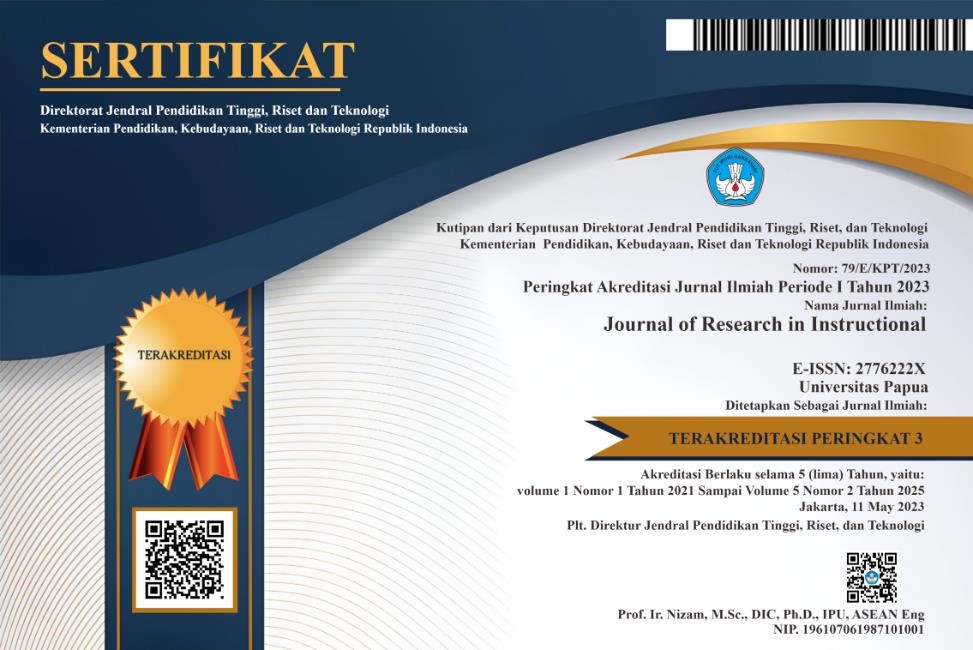
AUTHOR GUIDLINES
Author Guidelines
- Manuscripts should not have been published previously or be under consideration for publication elsewhere in any form.
- Multiple simultaneous submissions from the same author will not be accepted.
- The Editors of JRI reserve the right to make editorial changes in any manuscript accepted for publication to enhance clarity or style. The author will be consulted if the changes are substantial.
- Submitted manuscripts will be screened for possible unoriginal work/plagiarism. By submitting to JRI, authors are agreeing to undergo the originality check (software) program arranged by the journal.
- Articles written for JRI include perspective article that is scholarly reviews of fundamental concepts or prevalent ideas in a field and research article (maximum 5 years at the time of the submission) in the context of education and instruction. The manuscript is typed in Cambria, 11 pts in size, spaced 1.15 and printed on A4 paper 15 pages maximal. The manuscript (file) in Microsoft Word format is sent through the journal website https://jurnal.unipa.ac.id/index.php/jri/about/submissions by registering first.
- The name of the article main author and co-authors are listed without an academic degree and is placed under the title of the article. The author(s) should include the institution of origin and email address under the authors’ name section. There is no additional author when reviewing has been carried out.
- Articles can be written in Indonesian or English with essay format with a title in each section of the article. The article titles and subtitles of the articles are capitalized. The section title rating is capitalized at the beginning of each word. The section title and section title rankings are all without numbers/numbers, in bold, and flat left edges.
- Research article is expected to contain the following:
- Title (max 15 words);
- The author's name (without an academic degree);
- Indonesian abstract (in one paragraph, max. 200 words) and keywords (3-5 words);
- English abstract (in one paragraph, max. 200 words) and keywords (3-5 words);
- Introductions containing backgrounds, brief review, and research objectives (no subheadings);
- Method;
- Results containing the results section (there is a subheading, but optional)
- Discussions containing the discussion about results (there is a subheading, but optional);
- Conclusions containing conclusions and suggestions (without subheadings);
- Acknowledgment (if any) and
- References (contains only referenced sources).
Tables and pictures are numbered and titled.
Referenced sources are as many as possible libraries of the last 10 years.
Authors are requested to use Mendeley or any software manager. Preferred referrals are primary sources of research reports (including thesis, thesis, dissertation) or research articles in scientific journals or magazines.
Referrals and quotes using confined referral techniques (name, year). The inclusion of a source on a direct quotation should be accompanied by a description of the page number from which the quotation originates, for example (Bisnu, 2010, p. 47)
The list of references is arranged in the manner of the following examples and sorted alphabetically and chronologically by using APA style 7th edition.
Examples of referral list writing:
Journal Article
Grady, J. S., Her, M., Moreno, G., Perez, C., & Yelinek, J. (2019). Emotions in storybooks: A comparison of storybooks that represent ethnic and racial groups in the United States. Psychology of Popular Media Culture, 8(3), 207–217. https://doi.org/10.1037/ppm0000185
Magazine article references
Lyons, D. (2009, June 15). Don’t ‘iTune’ us: It’s geeks versus writers. Guess who’s winning. Newsweek, 153(24), 27.
Newpaper article
Carey, B. (2019, March 22). Can we get better at forgetting? The New York Times. https://www.nytimes.com/2019/03/22/health/memory-forgetting-psychology.html
Whole authored book
ackson, L. M. (2019). The psychology of prejudice: From attitudes to social action (2nd ed.). American Psychological Association. https://doi.org/10.1037/0000168-000
Chapter in an edited book
Aron, L., Botella, M., & Lubart, T. (2019). Culinary arts: Talent and their development. In R. F. Subotnik, P. Olszewski-Kubilius, & F. C. Worrell (Eds.), The psychology of high performance: Developing human potential into domain-specific talent (pp. 345–359). American Psychological Association. https://doi.org/10.1037/0000120-016
Report by a Government Agency References
National Cancer Institute. (2019). Taking time: Support for people with cancer (NIH Publication No. 18-2059). U.S. Department of Health and Human Services, National Institutes of Health. https://www.cancer.gov/publications/patient-education/takingtime.pdf
Conference presentation
Evans, A. C., Jr., Garbarino, J., Bocanegra, E., Kinscherff, R. T., & Márquez-Greene, N. (2019, August 8–11). Gun violence: An event on the power of community [Conference presentation]. APA 2019 Convention, Chicago, IL, United States. https://convention.apa.org/2019-video
Conference proceedings published in a journal
Duckworth, A. L., Quirk, A., Gallop, R., Hoyle, R. H., Kelly, D. R., & Matthews, M. D. (2019). Cognitive and noncognitive predictors of success. Proceedings of the National Academy of Sciences, USA, 116(47), 23499–23504. https://doi.org/10.1073/pnas.1910510116
Published Dissertation or Thesis References
Kabir, J. M. (2016). Factors influencing customer satisfaction at a fast food hamburger chain: The relationship between customer satisfaction and customer loyalty (Publication No. 10169573) [Doctoral dissertation, Wilmington University]. ProQuest Dissertations & Theses Global.
Unpublished Dissertation or Thesis References
Harris, L. (2014). Instructional leadership perceptions and practices of elementary school leaders [Unpublished doctoral dissertation]. University of Virginia.





